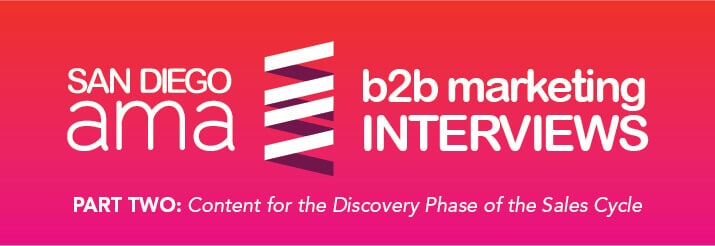The content marketing strategy for B2B companies changes throughout the sales funnel. In this second part of an interview by the SD AMA, Jeremy Durant of Bop Design discusses how content can be tailored specifically for the Decision Phase of the sales funnel for B2B firms.
All interviews were by Jimmy Page, Vice President of Content and Analytics, at the San Diego Chapter of the American Marketing Association for the segment, This Week in Marketing powered by wsRadio.com. All recordings can be accessed on the SD AMA website.
Jimmy: We spent the majority of the first segment talking about an overview of the content industry. How B2B companies are looking at it, and a high level understanding of how you’re looking at stages of the buying process, and applying content to it. We’re going to start really digging into pieces of the funnel and how you design content and think about content for those specific pieces. We’ll start with high to mid-funnel. For people who aren’t as familiar with the marketing funnel, what we’re talking about there is awareness-style marketing. More sort of high-level, making people understand what you’re doing. People who are in an informational research phase, those kinds of things. Jeremy, you mentioned the first stage in the buying process is what you called, “Discovery,” in the first segment. How do you identify a customer that’s in Discovery phase, based on behaviors?
Jeremy: You actually almost have to look at the Discovery phase from both sides. As the business, you’re discovering that client, and you’re trying to qualify them. It’s really a two-way street where both sides are trying to discover and qualify the other. I’m looking at certain behaviors with content, just certain personality behaviors with the client that I think are important. If a client seems to know better than I do in terms of content, that could be a major red flag. You want to make sure that they’re hiring you as an expert. If you’re supplying content, and they either disregard it, or have better ideas, even though you, as that business, have a tried-and-true process, that can be a major red flag. I look for little “superficial” things like that from a personality standpoint that I think are very important. What you’re doing there is you’re trying to qualify that client from a personality standpoint, to know if you can take this project from start to finish. With most b-to-b projects, it’s typically a long-term partnership. You’re going to be working with this person for months, if not years, so you want to get that right out of the way immediately. That definitely is, from a content standpoint, just seeing the reaction to certain content is a big thing. If they’re eager to learn, and they actually look at you as that expert, that’s a great sign.
Also, what you’re looking at is you’re trying to set expectations. For most clients they don’t go, now this may be their first time hiring your product, or finding a product or service like yours. You need to make sure that they have the proper expectations, so in that Discovery phase, you’re just supplying them with educational pieces on everything from budget, to timeline, to number of decision-makers, basically setting the expectation from start to finish of what needs to happen, because if you don’t set that expectation up front, in terms of project timeline or project expectation, it’s going to be doomed for failure down the way. That’s another big thing in terms of educating the content. Supplying educational content in that Discovery phase to make sure that they have the right expectations going forward.
Jimmy: How do you know what are these content pieces that I supply to someone who is in this Discovery phase, this kind of initial learning phase? If you’ve got an example, I know you’ve got a ton of B2B clients, something that you could give us as a story about how you’ve approached Discovery content for a B2B software company, or something like that.
Jeremy: Tried and true, the best Discovery piece of content that I think you can create, and I feel like every B2B firm needs to have this, is a simple buying guide. I talked about taking control of the conversation, taking control of the sales process. If you can be the one that’s supplying that prospect with a buying guide of the right questions to ask, let’s say as a software firm, “Hey, you’re looking to hire just an out-sourced, contract software firm to create something. What are those questions you need to ask? What are potential red flags?” That allows you, because keep in mind, you’re putting that buying guide together, guess what, you already have those answers ready to go. Typically, they’re already in your content piece, and then you’re taking control of the conversation, dictating the questions that are going to be asked to your competition. A buying guide, that’s the first piece of the content that we almost do with every content marketing project, because most people don’t have that yet. They’re like, “Oh, I shouldn’t be creating the buying guide, that should be a third party.” I’m like, “No, there isn’t a buying guide out there, so you might as well be the one sponsoring that content, and taking control of the conversation.”
Jimmy: What obstacles are you facing when you’re in the Discovery phase? It sounds really easy to create content that’s a) going to sell for you, and b) give people the information, all type of content that they need, but it’s not that easy, and I think we all know that. I think a lot of people struggle with this. What are the biggest obstacles you see in this phase?
Jeremy: The number one obstacle is always going to be doubt. When you look at the sales process, you almost have to look at a scale of, once you can outweigh doubt with evidence, that’s where you can get the sale, and what’s evidence? Evidence is the content. That’s where you’re taking somebody from that initial doubt, to peace of mind through the process. “Hey, they seem to know what they’re doing, and if they seem to know what they’re doing, they’re probably going to get this project done.” I always tell my staff and our clients, any of our content marketing clients, that you serve like you sell. Really, your number one brand promise, you know people talk about brand promise all the time, it’s just messaging. One of the top brand promises, or the way that you present your brand promise, is through your sales process. If your sales process is disorganized, not responsive, chances are your customer service, and your actual service delivery is going to be consistent with your sales process. Keep that in mind. Doubt is always number one. It’s kind of a nebulous term, but really, you’ve got to remember that prospects don’t know you from anyone. Really, what you want to do is provide enough evidence through content to outweigh the doubt.
Another big thing is budget. Obviously, every time price is going to be one of the first qualifiers. “Hey, what’s your budget?” Do they have a realistic budget, and how do you educate a prospect, through content, about what an appropriate budget is? That can be things like an info-graphic about your process. What you want to do with content is build value. Talk about, “Hey, here’s how many steps are involved in this particular process. Here’s how many different specialists we need involved. Here’s the number of hours.” I think that a lot of prospects may underestimate the time it takes to get something done. They just see the finished product, and they think it’s just magic, and it gets done. The more you educate up front about the process, and this typically goes into even the consideration phase at this point, the more that you talk about all the intricacies, and all the steps in the process, the more they will understand the value, and the more their budget will expand.
Jimmy: It makes a lot of sense. Where does blog content fit in here? You talked about it in the first segment a little bit. I know there are probably multiple stages of the funnel that blog content touches, on the B2B website side, but I have to assume, especially from a search engine perspective, there’s probably some ability to catch, from an acquisition perspective, people who aren’t aware at all in this top funnel. Am I right?
Jeremy: Yes, exactly. We consider, in our process, the blog the center of your content marketing strategy. Really, the blog content almost touches all parts of your content marketing. What you want to start out with, with any sort of blogging strategy, is an editorial calendar, typically wrapped around the key words you want to target. I always advise to, from an SEO standpoint, I think a lot of SEO people want to spread themselves too thin with way too many key words they’re targeting. Just come up with a wish list of 4 to 5 key word phrases that are reasonable, that you think you can be top 3 on Google within the next 6 months to a year. Come up with those key words, and then design a blogging strategy around those key words. Each month, you go from one key word phrase, to the next that you’re targeting, with blog content around that. Then, what you want to do with this blog content is repurpose it on as many platforms as possible. Just getting blog content written down is 95% of the battle. Why just have it on your website? A B2B website is great, because it does address your on-page SEO objectives, but why not start addressing that content, utilizing that content for off-page SEO, for lead nurturing, for social media. Keep in mind, the people reading your blog content are typically unqualified prospects. They’re not even on your radar yet. They’re on your website, they haven’t converted yet. You don’t even know who they are. They’re really at that Discovery phase.
Meanwhile, people that might be reading your email newsletter, which is re-purposed blog content, are already strategic partners, current clients, or qualified prospects. You’re really utilizing the same content. Keep in mind, I know with the Discovery versus the Consideration phase, you’re utilizing different content, but there is sometimes content that can be used for both. It just depends. You want to repurpose this content and address marketing objectives from leading nurturing, to off-page SEO, because, keep in mind, with this blog content, a lot of it could be used for guest blogging opportunities on high domain authority websites that are going to help with back-links to your site. Some may be more newsworthy. I know news wire services now have diminishing SEO returns, but it’s still good to drive traffic to your B2B website, and basically utilize that blog content for a press release, for a third-party validation. “Hey, this publication, Yahoo Finance, has published our article.” The client goes, “Hey, these guys are legitimate. I think they’re credible enough to do the job.”
Read more about content marketing and how it relates to the Consideration and Decision Phases of the sales funnel in Part III of this interview on content marketing for B2B firms.



